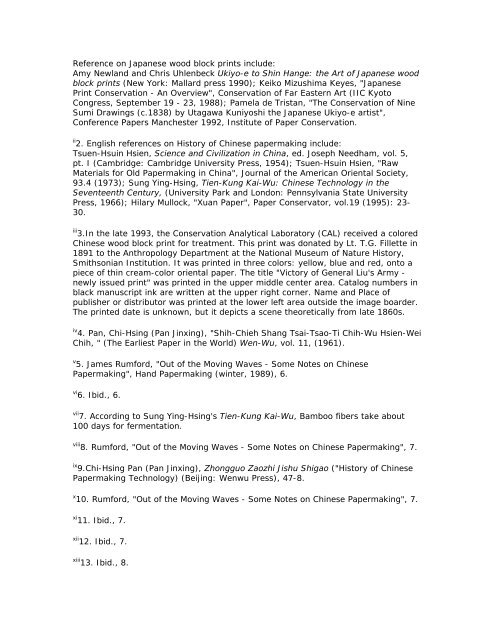technology, treatment, and care of a chinese wood block print
technology, treatment, and care of a chinese wood block print
technology, treatment, and care of a chinese wood block print
Create successful ePaper yourself
Turn your PDF publications into a flip-book with our unique Google optimized e-Paper software.
Reference on Japanese <strong>wood</strong> <strong>block</strong> <strong>print</strong>s include:<br />
Amy Newl<strong>and</strong> <strong>and</strong> Chris Uhlenbeck Ukiyo-e to Shin Hange: the Art <strong>of</strong> Japanese <strong>wood</strong><br />
<strong>block</strong> <strong>print</strong>s (New York: Mallard press 1990); Keiko Mizushima Keyes, "Japanese<br />
Print Conservation - An Overview", Conservation <strong>of</strong> Far Eastern Art (IIC Kyoto<br />
Congress, September 19 - 23, 1988); Pamela de Tristan, "The Conservation <strong>of</strong> Nine<br />
Sumi Drawings (c.1838) by Utagawa Kuniyoshi the Japanese Ukiyo-e artist",<br />
Conference Papers Manchester 1992, Institute <strong>of</strong> Paper Conservation.<br />
ii 2. English references on History <strong>of</strong> Chinese papermaking include:<br />
Tsuen-Hsuin Hsien, Science <strong>and</strong> Civilization in China, ed. Joseph Needham, vol. 5,<br />
pt. I (Cambridge: Cambridge University Press, 1954); Tsuen-Hsuin Hsien, "Raw<br />
Materials for Old Papermaking in China", Journal <strong>of</strong> the American Oriental Society,<br />
93.4 (1973); Sung Ying-Hsing, Tien-Kung Kai-Wu: Chinese Technology in the<br />
Seventeenth Century, (University Park <strong>and</strong> London: Pennsylvania State University<br />
Press, 1966); Hilary Mullock, "Xuan Paper", Paper Conservator, vol.19 (1995): 23-<br />
30.<br />
iii 3.In the late 1993, the Conservation Analytical Laboratory (CAL) received a colored<br />
Chinese <strong>wood</strong> <strong>block</strong> <strong>print</strong> for <strong>treatment</strong>. This <strong>print</strong> was donated by Lt. T.G. Fillette in<br />
1891 to the Anthropology Department at the National Museum <strong>of</strong> Nature History,<br />
Smithsonian Institution. It was <strong>print</strong>ed in three colors: yellow, blue <strong>and</strong> red, onto a<br />
piece <strong>of</strong> thin cream-color oriental paper. The title "Victory <strong>of</strong> General Liu's Army -<br />
newly issued <strong>print</strong>" was <strong>print</strong>ed in the upper middle center area. Catalog numbers in<br />
black manuscript ink are written at the upper right corner. Name <strong>and</strong> Place <strong>of</strong><br />
publisher or distributor was <strong>print</strong>ed at the lower left area outside the image boarder.<br />
The <strong>print</strong>ed date is unknown, but it depicts a scene theoretically from late 1860s.<br />
iv 4. Pan, Chi-Hsing (Pan Jinxing), "Shih-Chieh Shang Tsai-Tsao-Ti Chih-Wu Hsien-Wei<br />
Chih, " (The Earliest Paper in the World) Wen-Wu, vol. 11, (1961).<br />
v 5. James Rumford, "Out <strong>of</strong> the Moving Waves - Some Notes on Chinese<br />
Papermaking", H<strong>and</strong> Papermaking (winter, 1989), 6.<br />
vi 6. Ibid., 6.<br />
vii<br />
7. According to Sung Ying-Hsing's Tien-Kung Kai-Wu, Bamboo fibers take about<br />
100 days for fermentation.<br />
viii 8. Rumford, "Out <strong>of</strong> the Moving Waves - Some Notes on Chinese Papermaking", 7.<br />
ix 9.Chi-Hsing Pan (Pan Jinxing), Zhongguo Zaozhi Jishu Shigao ("History <strong>of</strong> Chinese<br />
Papermaking Technology) (Beijing: Wenwu Press), 47-8.<br />
x 10. Rumford, "Out <strong>of</strong> the Moving Waves - Some Notes on Chinese Papermaking", 7.<br />
xi 11. Ibid., 7.<br />
xii 12. Ibid., 7.<br />
xiii 13. Ibid., 8.
















